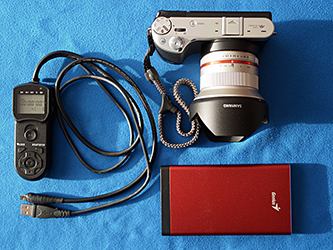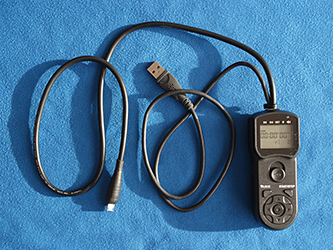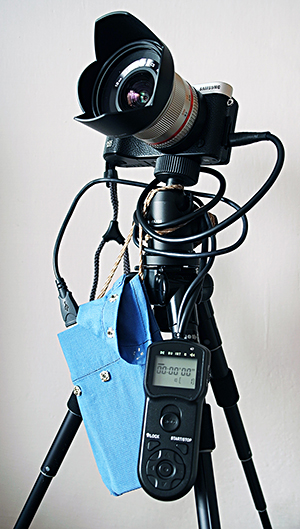| After years
of "timelapsing" with
Kodak P880, Ricoh GX100 and Ricoh GXR-A16 cameras, I decided to upgrade
my gear with a camera which would be more suitable for low-light
photography, namely wide-angle astrophotography. Since I wanted to stay
at the APS-C sensor size format (because of gear weight and size, but
also taking into account costs of a new camera and lenses), and taking
into account various features which I wanted my new camera to have
(e.g. a possibility to replace the memory card and battery without
removing the camera from a tripod, possibility to charge and trigger
the camera via a dedicated connector, tilting LCD, ...), I began to be
attracted by the Samsung NX1 camera, and namely by its cheaper sibling,
Samsung NX500.
In the meantime, it began to be almost certain that Samsung is going to
quit its NX camera business, the prices of both of these cameras
dropped, and the cameras began to disappear from the market. At that
time I decided to go for NX500, which houses the same APS-C sensor as
NX1 (which was reported to be on the top of APS-C sensors at that
time), lacks EVF and has somewhat weaker processing performance, but is
significantly smaller and still meets most of my time-lapse camera
requirements. I managed to purchase one of the very few remaining
pieces in Europe. Of course, I had quite mixed feelings about my
decision - purchasing an apparently great small camera, at very good
price, but a camera of a brand which was about to disappear from the
market. |
 |
Besides the camera itself, I purchased the Samyang 12mm F2.0 NCS CS manual wide-angle lens, Samyang 8mm F2.8 UMC Fish-eye II manual lens, JJC TM remote control and timer, and some other accessories. The main reason why I bought the external timer were some limitations of the camera's built-in time-lapse features, namely the absence of possibility of short view of the captured image while in this mode. Though I'm aware of the work of some folks working on modifications of the camera software (e.g. here), I somewhat prefer the "old fashion" external cable-control solution.
As the NX500 utilizes the same USB connector for both, charging and remoter control, I asked one of my friends, Lukáš Ronge, if it would be possible to couple both of these functions into one single connector, so that I could use charging and remote control simultaneously. After a short time I got back this modified JJC TM remote control: one of the two cables goes to an output from a power bank (or any other external power source), and the other goes into the camera. This solution enables e.g. timelapsing over the whole night, being limited by the memory card capacity only . It also allows to use the Quick View (a short display of a photo immediately after it is captured). Click the images below for larger ones.
 |
 |
 |
 |
On the
image at left you can see
the setup on a tripod - the camera being powered from a power bank in
the small blue pack, and controlled at the same time by the JJC TM
remote control. Some of my first timelapse videos with Samsung NX500 you can find in my 2016 gallery. During the daytime the image quality is about the same as with Ricoh GXR-A16, however for the wide-angle astrophotography the NX500 strongly outperforms Ricoh GXR-A16, being much less noisy and allowing higher ISO (up to about ISO3200). Of course, it can't compete with most of the latest full-frame cameras, but for the APS-C sensor it does a reasonably good job. While I manage to remove most of the noise when processing the raw files in Photoshop, the remaining (temporal) noise can be removed when rendering the final movie file. For details on this and examples see this case, and another case below it . ----------------------- For more recent examples of timelapses of the night sky taken with this camera, see my 2017, 2018 and 2019 galleries. |